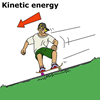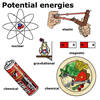We sometimes feel that we just don't have the energy to do something, or even that we are very energetic! This gives us the clue about what energy is. In Physics, an object has energy if it can cause changes to occur. Energy comes in many forms, many of which are either types of potential energy or kinetic energy.
Kinetic energy
 Kinetic energy is energy of movement. Anything that has mass and
that is moving has kinetic energy. The world is continuously in motion,
sometimes with objects being propelled by a force, like a car accelerating
from the lights, a ball in flight or an aircraft landing. In other cases
experiencing no net force and moving at a constant speed like an ice skater
gliding in a straight line.
Kinetic energy is energy of movement. Anything that has mass and
that is moving has kinetic energy. The world is continuously in motion,
sometimes with objects being propelled by a force, like a car accelerating
from the lights, a ball in flight or an aircraft landing. In other cases
experiencing no net force and moving at a constant speed like an ice skater
gliding in a straight line.
The word kinetic has an interesting derivation - it comes from a Greek word meaning, "to move". Our word cinema comes from the same source, so "movies" is an appropriate description!
Potential energy
 Stored energy is called potential energy; an object that has potential
energy may release that stored energy to be transformed to another form
of energy. To store energy, work must be done, such as winding up a spring,
charging a battery or lifting a vase onto a shelf.
Stored energy is called potential energy; an object that has potential
energy may release that stored energy to be transformed to another form
of energy. To store energy, work must be done, such as winding up a spring,
charging a battery or lifting a vase onto a shelf.
In the simplest classification system, potential energy can be classified in four ways:
- Gravitational potential energy
Gravitational potential energy is energy stored in a system of objects as a result of the exertion of a gravitational force on each other. For example; the Earth and a vase on a shelf. The vase is said to possess gravitational potential energy due to its position high on the shelf.
- Electrical potential energy
Electrical potential energy is energy stored in a system of charged particles as a result of the exertion of an electric force on each other. Chemical energy, such as that found in batteries, fuel and food, and elastic potential energy like that found in a stretched elastic band are both forms of electric potential energy.
- Magnetic potential energy
Magnetic potential energy is energy stored in a system of magnets as a result of the exertion of a magnetic force on each other. When two magnets attract or repel each other potential energy can be stored in their relative positions. For example, two magnets which are repelling each other, when held together have potential energy, in that when they are released they move apart.
- Nuclear potential energy
Nuclear Potential Energy is energy stored in the nucleus of an atom as a result of the exertion of the strong nuclear force between the protons and neutrons.
Potential to kinetic energy
Here is a way of experiencing elastic potential and kinetic energies.
Take a rubber band and stretch it. You are working to store potential
energy. You can also feel the force of the stretched rubber band as the
potential energy is increased within the rubber, ready to be released.
- What happens if you let one end go?
- What happens if you ease the band back to the original position?
- In both cases you initiated an energy transformation, but where does it go?
When you let go of one end of the rubber band the stored energy is released quickly and could cause a bit of pain! This is energy transformation in action. In a rubber band powered model aircraft the energy is stored by winding the band, and is transformed more slowly as the rubber band works to spin the propeller, moving air and producing sound. Using gears can transform the energy even more slowly.
Sound, another form of energy, is also produced if you stretch the rubber band between your finger and thumb and "twang" it. It is the movement of the rubber band that vibrates the air to produce the sound. A transformation of potential to kinetic energy in the form of vibration of the rubber band and the sound in the air.
Think again about the vase that was placed on the shelf. It has gravitational potential energy. If the vase is knocked off the shelf, it falls towards the ground, probably breaking with a loud noise as it hits the floor. In this case, the gravitational potential energy is transformed to kinetic energy as it falls under the influence of gravitational force, then the energy is transformed as the vase breaks, and sound is produced.

|
Energy conversion |
Potential to kinetic and back again
Take a piece of string and tie a small load to the end. Hold the string
at one end and pull the load to one side then let the load go. You now
have gravitational potential energy being transformed into kinetic energy
and then back again.
- Where are the gravitational potential energy and kinetic energy at their maximum levels?

|
Energy changes in a pendulum |
| Copyright owned by the State of Victoria (Department of Education and Early Childhood Development). Used with Permission. |